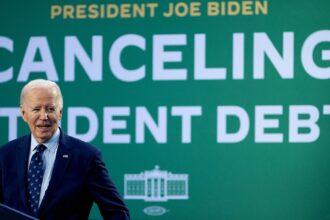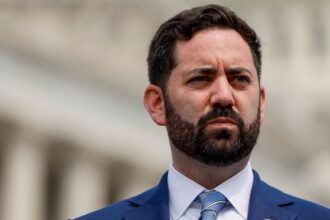
Since March 2020, federal student loan borrowers have had their monthly loan payments frozen and their interest rates dropped to 0%. The payment pause was made possible by the CARES Act. And although these benefits were made to be temporary, the Education Department has extended the pause multiple times since it was enacted.
But for many borrowers, a pause in student loan payments didn’t translate to a better overall financial outlook, according to a study published in a paper series by the National Bureau of Economic Research (NBER).
In fact, household leverage increased by about $1,200 or 3% for households subject to the pause, the paper stated. Moreover, borrowers subject to the payment pause owed $1,800 in other debt and owed $20 more in monthly payments.
“We find a large stimulus effect, as borrowers substitute increased private debt for paused public debt,” the paper said.
“Comparing borrowers whose loans were frozen with borrowers whose loans were not frozen due to differences in whether the government owned the loans, we show that borrowers used the new liquidity to increase borrowing on credit cards, mortgages, and auto loans rather than avoid delinquencies.”
Still, the pause led to a sharp drop in student loan delinquencies and an increase in overall credit scores, the paper said.
“This is good news for debt pauses as stimulus payments but it’s bad news if you think that debt pauses are just the nudge some people need to get their financial house in order,” the paper said.
But despite multiple extensions since 2020, the student loan payment pause is coming to an end. The debt-ceiling deal recently passed by Congress contains a provision that would prevent the Education Department from extending the pause once more after August 30.
Still, the White House had announced it sought to end the pause by the end of summer at the latest.
In November, the White House said student loan payments would restart in 60 days after a Supreme Court decision on Biden’s student loan forgiveness plan or June 30, whichever comes first.
“We will ensure a smooth return to repayment process,” Education Secretary Miguel Cardona said on Twitter.
Plus, the Education Department had asked student loan companies to prepare for an end to the student loan payment pause, according to documents obtained by Politico.
“Servicers shall extend the temporary 0% interest rate, initially implemented with CR 5475, through 08/31/2023,” a government document said.
If you have private student loans, you won’t benefit from federal forgiveness programs. But you can lower your monthly payments by refinancing to a lower rate. You can visit Credible to get your personalized rate in minutes.
DEBT CEILING DEFAULT WOULD BATTER HOUSING MARKET: ZILLOW
Senate passes legislation to repeal Biden’s student loan forgiveness plan
The Senate in June voted to block President Joe Biden’s student loan forgiveness plan, which aims to forgive up to $20,000 in federal student loans for eligible Americans. However, Biden said he would veto the resolution.
Proposed by Louisiana Senator Bill Cassidy, the resolution was made possible under the Congressional Review Act, which the Government Accountability Office said makes Biden’s plan a rule. Under the Act, lawmakers in the House and Senate can vote to block the president from implementing such a rule.
“It’s something of a slap in the face to Americans who chose more affordable college options or worked their way through school to avoid taking on student loans, or whose parents scrimped and saved to put them through college,” Sen. John Thune, R-S.D., said on the Senate floor before the vote.
However, the SBPC and the American Federation of Teachers said that the resolution would reinstate the student loans of more than 260,000 public servants. And they said another two million workers would lose progress toward debt relief under the Public Service Loan Forgiveness (PSLF) program.
Still, Biden’s student loan forgiveness plan remains under review by the Supreme Court. The high court is expected to make a decision on that matter this month.
If you’re a private student loan borrower, you won’t benefit from Biden’s student loan forgiveness plan. But you can reduce your monthly payments by refinancing to a lower rate. You can visit Credible to compare your options, without affecting your credit score.
BIDEN ADMINISTRATION APPROVES $42B IN STUDENT LOAN FORGIVENESS UNDER UPDATED PSLF PROGRAM
Supreme Court weighs in on Biden’s student loan forgiveness plan
Since February, the Supreme Court has been reviewing two lawsuits brought against Biden’s debt relief plan. One involves the states of Nebraska, Missouri, Arkansas, Iowa, Kansas and South Carolina. These states claimed the plan would unlawfully harm their tax revenues and said the president was misinterpreting the Higher Education Relief Opportunities for Students (HEROES) Act of 2003 to fulfill a campaign promise. Under HEROES, barriers to student loan forgiveness can be brought down during national emergencies. Biden had claimed the COVID-19 pandemic qualified as such an emergency.
In another case, two individuals had argued that Biden’s plan was unlawful because it would prevent them from enjoying all its benefits. They also argued that the public was not given time to review the initiative.
“Americans should be able to have a little more breathing room as they recover from the economic strains associated with the COVID-19 pandemic,” the White House said in a statement.
One activist group has supported Biden’s plan since it was announced in 2022, but believes he has the power to do more
“We firmly believe that the President has the power to go further,” the Student Debt Crisis Center (SDCC) said in a statement. “SDCC urges President Biden to cancel more debt automatically to ensure lower-income and working-class families receive meaningful support, fully invest in addressing racial equity issues, and maximize the positive economic effects of debt cancelation.”
Student loan forgiveness could benefit millions of Americans struggling with their finances. In fact, borrowers have experienced food insecurity at a rate 61% higher than the national average between 2020 and 2022, according to a report by the SDCC.
“Broad-based student debt cancellation will free millions of Americans to invest in their futures, support their families, and contribute to their communities and the economy,” Natalia Abrams, the president & founder of the SDCC. “While this announcement is a major win for many, it is important to stress that $10,000 will leave many others still crushed by debt and important details will determine who has access to much-needed relief. We will continue to fight to support families with large debts, to further address racial equity issues, and to end the student debt crisis once and for all.”
If you hold private student loans, you won’t be able to qualify for any federal forgiveness. But you can lower your monthly payments by refinancing to a lower rate. You can visit Credible to speak with a student loan expert and get your questions answered.
Have a finance-related question, but don’t know who to ask? Email The Credible Money Expert at [email protected] and your question might be answered by Credible in our Money Expert column.
Read the full article here








